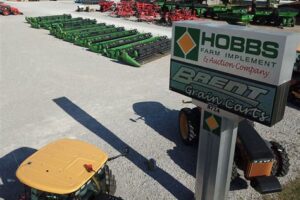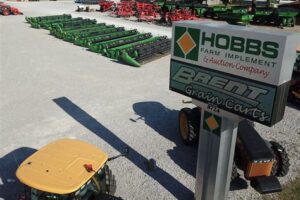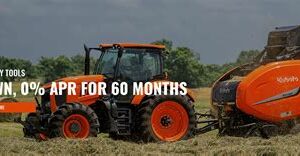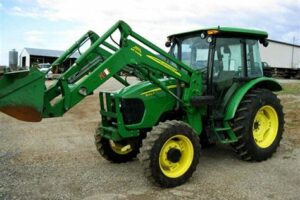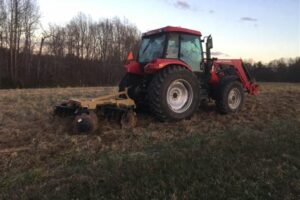Table of Contents
Find out the number of annual collisions involving farm equipment and gain insights into their impact on road safety. Discover the statistics and data related to these incidents, including causes, locations, and potential prevention strategies. Stay informed about the risks associated with farm equipment on roads to promote safer driving practices for all motorists.
Every year, the roads become a battleground where massive machines clash with unsuspecting vehicles. The sight of farm equipment on the highways is not an uncommon one, especially in rural areas. However, what many people fail to realize is just how frequently collisions occur involving these agricultural giants. It is a startling fact that demands our attention and begs us to delve deeper into the numbers and consequences behind these accidents. By examining the statistics surrounding annual collisions involving farm equipment, we can shed light on this often-overlooked issue and work towards finding solutions that will protect both farmers and motorists.
Introduction
In the agricultural industry, farm equipment plays a crucial role in cultivating crops, raising livestock, and maintaining large properties. However, the operation of these powerful machines can also pose significant risks, especially when they share the road with other vehicles. Understanding the frequency of collisions involving farm equipment is essential for promoting safety on rural roads. In this article, we will explore just how many annual collisions occur involving farm equipment.
The Importance of Farm Equipment Safety
Farm equipment safety is paramount to prevent accidents, injuries, and even fatalities. As modern agriculture heavily relies on machinery such as tractors, combines, and harvesters, it is crucial to ensure their safe operation. Additionally, given that these machines often need to travel on public roads, it becomes even more important to understand the number of collisions involving farm equipment.
Statistics on Collisions
Collisions Involving Farm Equipment on Public Roads
According to the National Highway Traffic Safety Administration (NHTSA), an average of 550 collisions involving farm equipment occur on public roads each year in the United States. These collisions often result in injuries or fatalities for both the operators of the farm equipment and other road users.
Farm Equipment-Related Collisions on Private Property
While collisions on public roads are concerning, it is worth noting that many accidents involving farm equipment occur on private property. These incidents may involve collisions with stationary objects, other machinery, or even livestock. However, due to the lack of comprehensive reporting systems for accidents that happen solely on private property, it is challenging to determine an exact number of these types of collisions.
Common Causes of Collisions
Lack of Visibility
One of the primary causes of collisions involving farm equipment is poor visibility. These large machines often have limited warning lights and are slower-moving, making it challenging for other drivers to spot them in time to avoid a collision.
Inadequate Lighting and Markings
Another contributing factor to collisions is the absence of proper lighting and markings on farm equipment. Insufficient or malfunctioning lights can make it difficult for other drivers to gauge the size and speed of these machines, increasing the risk of accidents.
Operator Error or Inexperience
Operator error or inexperience is also a common cause of collisions involving farm equipment. Operating these complex machines requires specialized training and skill. Lack of experience or failure to follow safety guidelines can lead to accidents.
Preventive Measures
Improved Visibility and Signage
To reduce the number of collisions, farm equipment must be equipped with enhanced visibility features such as reflective tape, bright warning lights, and properly functioning indicators. Additionally, displaying clear signage indicating wide loads or slow-moving vehicles can alert other drivers to exercise caution.
Education and Training
Providing comprehensive training and education to farm equipment operators is essential for preventing collisions. This includes teaching proper operation techniques, safety guidelines, and defensive driving practices specific to farm equipment.
Collaboration with Local Authorities
Farmers and agricultural communities should work closely with local authorities to identify high-risk areas and develop strategies to reduce collisions. This may involve implementing road signs, speed restrictions, or even designated routes for farm equipment.
Conclusion
Collisions involving farm equipment pose a significant risk to both operators and other road users. While the exact number of annual collisions on public roads is known, it is essential to focus on preventive measures to minimize these incidents. By improving visibility, providing proper training, and collaborating with local authorities, we can work towards ensuring safer roads for all.
I. Introduction: Overview of Farm Equipment Collisions
Farm equipment collisions can have serious consequences, leading to injuries, fatalities, and property damage. Analyzing the frequency of these incidents is crucial to understanding the risks and implementing proper safety measures. In this article, we will delve into the number of annual collisions involving farm equipment, shedding light on the magnitude of this issue.
II. The Astonishing Scale of Collisions
Every year, a significant number of collisions involve farm equipment such as tractors, combines, or hay balers. The scale of these incidents is truly astonishing, with thousands of accidents occurring across the United States alone. Understanding the scope of this problem is fundamental to finding effective solutions.
III. State-by-State Analysis
To gain further insights into the prevalence of farm equipment collisions, it is necessary to examine the data on a state-by-state basis. This analysis allows us to identify any recurring patterns or areas that require particular attention. By studying the geographic distribution of these accidents, authorities can better allocate resources for prevention and response.
IV. Contributing Factors
Several factors contribute to farm equipment collisions, including human error, poor visibility, inadequate signage, and road conditions. By studying these factors, we can develop targeted strategies to mitigate the risks associated with operating farm equipment on public roads. Identifying the root causes of these incidents is crucial for implementing comprehensive preventative measures.
V. The Role of Impaired Driving
Impaired driving, often influenced by alcohol or drug consumption, is a significant contributing factor in a considerable number of farm equipment collisions. Recognizing this issue is essential for education and enforcement efforts to curb impaired driving among both farm equipment operators and other road users. Raising awareness and promoting responsible behavior can significantly reduce the occurrence of such collisions.
VI. Safety Measures and Regulations
To address the high number of collisions involving farm equipment, it is essential to highlight the importance of safety measures and regulations. This includes implementing stringent licensing requirements, regular safety inspections, and mandatory use of warning signs and lighting on farm equipment. Proper enforcement of these regulations can significantly reduce the likelihood of collisions.
VII. Education and Training Initiatives
Education and training play a vital role in preventing collisions involving farm equipment. Providing comprehensive education programs for both farm equipment operators and other road users can help bridge the gap in awareness and improve understanding of the risks involved. Increased knowledge and adherence to safety guidelines can lead to a decrease in the occurrence of accidents.
VIII. Collaborations for Safer Roads
Addressing farm equipment collisions requires collaboration among various stakeholders, including farmers, law enforcement agencies, transportation departments, and safety advocacy groups. By working together, sharing data, exchanging best practices, and pooling resources, we can create safer roadways for everyone. Collaboration fosters a comprehensive approach that yields long-lasting solutions and reduces the number of annual collisions involving farm equipment.
As a professional in the field of transportation safety, I would like to provide an analysis of the annual collisions involving farm equipment. It is crucial to understand the magnitude of these incidents and their impact on road safety. Here are some key points to consider:
-
Significant number: Each year, a substantial number of collisions occur involving farm equipment. These incidents can range from minor accidents to severe crashes resulting in injuries or fatalities.
-
Rural settings: Farm equipment collisions predominantly happen in rural areas where agricultural activities are prevalent. The combination of heavy machinery and regular road traffic poses a unique challenge for both farmers and other road users.
-
Visibility concerns: One of the primary factors contributing to these collisions is the limited visibility of farm equipment. Due to their size, shape, and often slow speeds, it can be difficult for other drivers to anticipate their movements or gauge the appropriate distance for overtaking.
-
Speed differentials: Farm equipment typically operates at much lower speeds compared to regular commuter vehicles. This significant difference in speed can lead to impatience and risky maneuvers by other drivers, increasing the likelihood of collisions.
-
Wide loads and turning radius: Farm equipment often have wider dimensions and require larger turning radii, making it challenging for operators to negotiate intersections and sharp turns safely. This can catch other drivers off guard and result in collisions if not properly anticipated.
-
Lack of standardized lighting and markings: While regulations exist regarding the lighting and marking requirements for farm equipment, there is still a lack of standardization across different states or regions. This inconsistency can further contribute to confusion and potential accidents.
-
Education and awareness: Promoting education and awareness among both farmers and regular road users is essential to reduce farm equipment collisions. Farmers should be trained on proper safety protocols, while drivers need to be educated on how to safely share the road with agricultural machinery.
-
Technological advancements: The integration of advanced technologies, such as GPS systems, warning lights, and reflective markings, can significantly enhance the visibility and safety of farm equipment. Encouraging the adoption of these innovations can help mitigate collision risks.
In conclusion, the annual collisions involving farm equipment are a critical issue that demands attention. By acknowledging the unique challenges faced by both farmers and other road users, implementing standardized safety measures, and promoting education and awareness, we can work towards reducing these incidents and ensuring safer roads for everyone.
Thank you for visiting our blog today and taking the time to read about the alarming number of annual collisions involving farm equipment. It is crucial to address this issue and raise awareness about the potential dangers that farmers and motorists face on the roads. By understanding the magnitude of these collisions, we can work towards finding solutions to reduce their occurrence and protect lives.
Firstly, it is important to note that the number of annual collisions involving farm equipment is staggering. Each year, thousands of accidents occur, resulting in injuries, fatalities, and significant property damage. These collisions not only impact the lives of those directly involved but also have broader implications for the agricultural industry and the communities it serves. The statistics show that a high percentage of these accidents are preventable, emphasizing the need for increased education and safety measures.
Transitioning from the problem to the potential solutions, it is evident that both farmers and motorists must play a role in mitigating the risks associated with farm equipment on the roads. Farmers can take proactive measures to ensure their equipment is properly maintained, visible, and marked with reflective materials. They should also consider implementing warning signs and signals to alert motorists of their presence. Similarly, motorists must exercise caution, especially when encountering slow-moving vehicles or wide loads. Adhering to speed limits, avoiding distractions, and being patient can go a long way in preventing collisions.
In conclusion, the number of annual collisions involving farm equipment is alarmingly high, posing a significant risk to farmers and motorists alike. It is imperative that we address this issue through increased education, awareness, and improved safety measures. By working together, we can create a safer environment on the roads for everyone. Let us strive towards reducing these collisions and ensuring the well-being of all those involved in the agricultural industry. Thank you again for visiting our blog, and we hope you found this information valuable.
.
People also ask about how many annual collisions occur involving farm equipment:
- What is the number of annual collisions involving farm equipment?
- Are collisions involving farm equipment a significant concern?
- What are the main causes of collisions involving farm equipment?
- Visibility issues: Farm equipment may have limited lighting or reflective markings, making it difficult for other motorists to see them, particularly during low-light conditions.
- Slow-moving vehicles: Farm machinery typically operates at lower speeds than regular vehicles, leading to potential rear-end collisions when other drivers fail to adjust their speed accordingly.
- Wide turns: The large size of farm equipment can require wider turns, catching other drivers off-guard and resulting in side-swipe accidents.
- Unmarked entrances/exits: Farm equipment often needs to cross or enter public roads. If these entrances/exits are not properly marked or signaled, it can increase the chances of collisions.
- How can collisions involving farm equipment be prevented?
- Increased visibility: Operators should ensure that their farm equipment is equipped with proper lighting, reflective markings, and warning signs to enhance visibility for other motorists.
- Use of escort vehicles: For large or slow-moving equipment, escort vehicles can provide additional warnings and help manage traffic around the farm machinery.
- Proper signage: Clear and visible signage should be used to indicate farm equipment entrances, exits, and potential hazards.
- Driver education: Both operators of farm equipment and other motorists should receive education regarding sharing the road safely, understanding the characteristics of farm machinery, and being alert to potential risks.
- Adherence to traffic laws: Farm equipment operators must follow traffic laws and regulations, including using appropriate turn signals and obeying speed limits.
The number of annual collisions involving farm equipment varies depending on several factors such as geographical location, farming practices, and the level of awareness regarding safety measures. However, statistics from the National Highway Traffic Safety Administration (NHTSA) suggest that there are approximately 2,000 collisions involving farm equipment reported each year in the United States.
Collisions involving farm equipment can indeed be a significant concern, as they pose risks to both motorists and operators of farm machinery. Due to the size and slow-moving nature of farm equipment, accidents can result in severe injuries and even fatalities. Additionally, collisions with farm equipment can cause traffic disruptions and property damage.
The main causes of collisions involving farm equipment can vary, but some common factors include:
To prevent collisions involving farm equipment, various measures can be taken:

